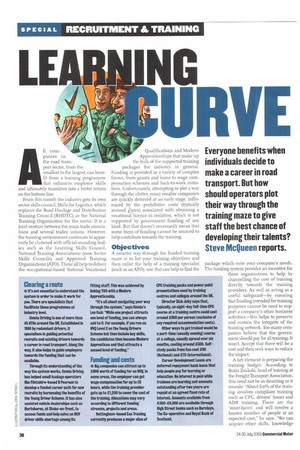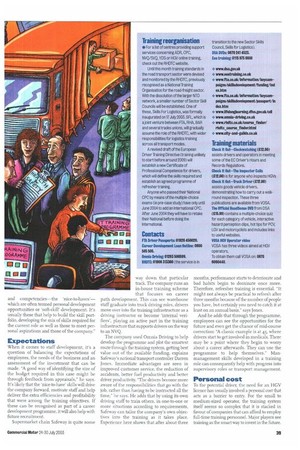A „ com
Page 38

Page 39

If you've noticed an error in this article please click here to report it so we can fix it.
panies in the road transport sector, from the smallest to the largest, can benefit from a training programme that enhances employee skills and ultimately translates into a better return on the bottom line.
From this month the industry gets its own sector skills council, Skills for Logistics, which replaces the Road Haulage and Distribution Training Council (RHDTC) as the National Training Organisation for the sector. It is a joint venture between the main trade associations and several trades unions. However, the training environment continues to apparently be cluttered with official-sounding bodies such as the Learning Skills Council, National Training Associations (now Sector Skills Councils) and Approved Training Organisations (ATO). These all help to deliver the occupational-based National Vocational Qualifications and Modern Apprenticeships that make up the bulk of the supported training packages for industry in general. Funding is provided in a variety of complex forms, from grants and loans to wage compensation schemes and back-to-work initiatives. Unfortunately, attempting to plot a way through the clutter, many smaller companies are quickly deterred at an early stage, influenced by the prohibitive costs (typically around L900) associated with obtaining a vocational licence in isolation, which is not supported by government funding of any kind. But that doesn't necessarily mean that some form of funding cannot be sourced to help contribute towards the training.
Objectives
A smarter way through the funded training maze is to list your training objectives and then enlist the help of a training specialist (such as an ATO), one that can help to find the package which suits your company's needs. The funding system provides an incentive for these organisations to help by channelling the cost of training directly towards the training providers. As well as acting as a useful safeguard—by ensuring that funding intended for training purposes cannot be used to support a company's other business activities—this helps to preserve and sustain the integrity of the training network. Too many companies believe that the government should pay for all training, It won't. Accept that there will be a cost and then seek ways to reduce the impact.
A key element is preparing the training budget. According to Brain Zsulcala, head of training at the Freight Transport Association, this need not be as daunting as it sounds: "About 6o% of the training involves compliant training such as CPC, drivers' hours and ADR training. These are the 'must-haves' and will involve a known number of people at an expected cost," he says. "We can acquire other skills, knowledge
and competencies—the 'nice-to-haves '— which are often termed personal development opportunities or `soft-skill' development. It's usually these that help to build the skill portfolio, developing the mix of skills required for the current role as well as those to meet personal aspirations and those of the company."
Expectations
When it comes to staff development, it's a question of balancing the expectations of employees, the needs of the business and an assessment of the investment that can be made. "A good way of identifying the size of the budget required in this case might be through feedback from appraisals," he says. It's likely that the 'nice-to-have' skills will drive the company forward, motivate staff and help deliver the extra efficiencies and profitability that were among the training objectives. If these can be recognised as part of a career development programme, it will also help with future recruitment.
Supermarket chain Safeway is quite some way down that particular track. The company runs an
in-house training scheme that focuses on career path development. This can see warehouse staff graduate into truck driving roles, drivers move over into the training infrastructure as a driving instructor or become 'internal verifiers', playing an active part in the training infrastructure that supports drivers on the way to an NVQ.
The company used Omnia Driving to help develop the programme and plot the smartest route through the training system, getting best value out of the available funding, explains Safeway's national transport controller Darren Jones, Immediate advantages are seen in improved customer service, the reduction of accidents, better fuel productivity and better driver productivity. The drivers become more aware of the responsibilities that go with the job, rather than having to be instructed all the time," he says. He adds that by using its own driving staff to train others, in one-to-one or more situations according to requirements. Safeway can tailor the company's own objectives into the training as it takes place. Experience here shows that after about three months, performance starts to deteriorate and bad habits begin to dominate once more. Therefore, refresher training is essential. "It might not always be practical to refresh after three months because of the number of people you have, but certainly you need to catch it at least on an annual basis," says Jones.
And he adds that through the programme, employees can see the opportunities for the future and even get the chance of mid-course correction: "A classic example is at 45, where drivers start to get involved in medicals. There may be a point where they begin to worry about a career afterwards. They can use the programme to help themselves." Manmanagement skills developed in a training role can consequently help with progress into supervisory roles or transport management.
Personal cost
To the potential driver, the need for an HGV licence has usually involved a personal cost that acts as a barrier to entry. For the small to medium-sized operator, the training system itself seems so complex that it is stacked in favour of companies that can afford to employ full-time training personnel. Major players see training as the smart way to invest in the future.




























































































































































